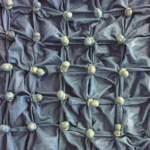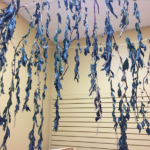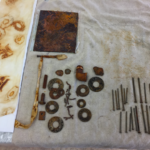Keely Halward Allyson Clay, Saskia Jetten, and Natalie Grambow formed The SAMARACOLLECTIVE as a group of individually practicing artists in November 2019. They seek tocultivate connection as a source of artistic growth. They invite the cross-pollination of ideas,activities, knowledge, sources of inspiration and technique, and meet regularly to put this intoaction. As individual artists, they practice a range of disciplines including printmaking, textile arts,painting, drawing, mixed media, installation, music, art education, text art and applied arts. Fromemerging to well-established professional art backgrounds, they rely on and value each other’sunique perspectives and experiences for both their individual and collective development.
In an early discussion with the SCAC director, we were encouraged to consider the residency as a site of research and development and to focus less on the production of works for exhibition or engagement with the public. This turned out to be a fruitful three months for us as artists, working in a space that we would otherwise not have been able to procure at that time. This allowed us to concentrate on depth of research and importantly become even more experimental than we may have otherwise been if we had had to focus on output. Our collective was born from the need to connect and to play and this allowed us to truly live these out during the residency.
Our collective practice in the space was anchored by Indigo dyeing. We started and maintained an indigo dye vat (otherwise known as “the Goddess”) for the three months. We co-existed with her in the studio throughout the residency, each of us drawing from her for inspiration for much of our work. The Indigo pot was “awoken” daily, through heating up and the managing of chemistries, and became a ritual in our working routines.
In the final month of our residency we embarked on more determined and fully collaborative works. The starting point for these collaborations was the blank artist book made by Saskia, which we call “the mobile studio” because it is small and portable and could circulate outside the studio. We take turns making work in this book. In this way we can keep our collaboration active even when we weren’t in proximity, and it helped us during times when one of us was self-isolating. For further collaboration works the process we adopted is similar, with each of us making a work (anything, of any scale) to be expanded on by the next person. This opened up the opportunity to experiment beyond the vocabulary of the dyeing, tying, sculpting and printmaking we had mostly been focused on. We are still in the beginning stages of this part of our work, and it is to be continued after the residency. It represents where the residency took us, and what we are taking forward.




